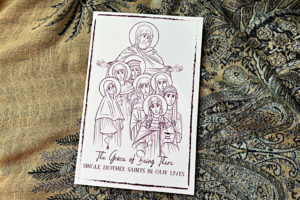I love words. Words are my toys, and they’re my tools. I think with them, I work with them, I play with them. I use them to interact with people, and I use them to understand the world.
And while I’d like to say that I love all words equally, that’s not true. I have favorites. And my favorite word of all words is philoxenia.
Philoxenia isn’t an English word. It’s a Greek word, and it often gets translated into English as hospitality. But hospitality, the way most of us think of hospitality, is about entertaining. It’s about having friends over for dinner, or hosting a party.
But entertaining people you know and love is nothing more than a ghost of philoxenia, a shadow, a half-remembered image.
The word philoxenia literally means “the love of strangers.” And in ancient Greece, philoxenia was considered one of the most important virtues. Philoxenia required you to welcome anyone who came to your door as an honored guest, to meet all of their needs while they were with you, and to supply them with what they would need for their journey when they left.
Philoxenia is what drives my advocacy for people with disabilities and for people in other marginalized groups.
Philoxenia calls me to open the door to other people, and to welcome them to the table.
A leg in Mrs. Monagan’s closet
When I was a little girl, no more than 4 or 5 years old, I had been welcomed to the table at Mrs. Monagan’s house. Mrs. Monagan was a friend of my mother’s. She was a very proper lady, and when she invited my mother over for tea, she included me. After I had enjoyed my juice and cookies, and endured as much grown-up conversation as a young child can, Mrs. Monagan suggested that I get the box of Lincoln Logs out of her coat closet and build something while she and Mom continued their visit.
So I opened the closet door, and pushed the coats out of the way, and there, next to the Lincoln Logs, I saw a leg! A full-sized, human leg.
I ran to tell Mrs. Monagan, and to my surprise, she wasn’t at all surprised. She explained that her husband had been in an accident many years before, and that one of his legs had been injured so badly that it wouldn’t ever heal. So the doctors had removed his leg. And ever since that time, he had used a prosthetic leg. It was such an ordinary thing to her that she hadn’t thought to mention that he kept a spare leg in the closet.
Making prosthetics seem ordinary
Mrs. Monagan wanted me to see it as ordinary, too. She wanted me to understand that some people keep spare legs in their closet, and it’s no big deal. So, a few days later, Mr. and Mrs. Monagan took me to the workshop where Mr. Monagan’s prosthetic legs had been made.
A couple of the employees welcomed me to their workshop. They talked with me about their work. They showed me racks and shelves filled with prosthetic arms and legs, and they helped me understand why so many different designs were necessary and how they worked. And, mostly, they helped me see that lots of people use prosthetic limbs. If it wasn’t common, they wouldn’t have so many of them at the store! So keeping a spare leg in a closet must be far more ordinary than I had known. It’s something that some people just do.
A house like a gymnasium
And, of course, some people just use wheelchairs. Like my mom’s cousin. I was about 10 years old when I met him, and I was intensely curious about his wheelchair. But I had been taught that it wasn’t polite to ask other people questions about their bodies. So I didn’t ask. I just watched.
When we went inside his house, I was even more curious, because his house had pullies and trapeze bars everywhere. To me, his house looked like a gymnasium, where gymnasts might be practicing for the summer Olympics.
And while I couldn’t ask him questions about his body, I had never been told not to ask questions about pullies and trapeze bars, so I asked. He showed me how he used the equipment to transfer himself from his wheelchair to his favorite armchair and back again. He showed me the equipment he used in the bathroom and in the kitchen, explained all the gear that supported his independence. And he pointed out his place at the table. There wasn’t a chair there, because he brought his own.
He made it all seem very ordinary. He knew that it wasn’t ordinary. He knew that someone who used a wheelchair wasn’t guaranteed a place at the table – even his own table.
But I didn’t know that. And if he had told me that, I’m not sure that I’d have believed him.
Curb cuts and a place at the table
I was in college when I found out how very much I didn’t know. I loved being a college student. It was in college that I first encountered the Oxford English Dictionary. It was in college that I met other people who loved words as much as I did.
And it was in college that I learned that people with disabilities didn’t always have a place at the table.
Now, the fact that I don’t have a mobility impairment gives me a certain amount of privilege. When I was in college, this privilege allowed me not to notice the many ways that the campus excluded people with mobility impairments. If you used a wheelchair, you could probably get into the cafeteria and the gym. Maybe the library. You couldn’t get into the dormitories, or the academic buildings (except maybe the brand-new, state-of-the-art journalism building). There were no ramps, and no curb cuts, anywhere on campus.
Architectural barriers and the editor’s plan
This was in the 1970s. It was long before the ADA, but the Architectural Barriers Act was already law. And the editor of the campus newspaper realized that, because the university received federal funds, it had a legal requirement to remove architectural barriers. During our junior year, she published an impassioned editorial arguing that we needed curb cuts. She argued that if the state didn’t appropriate the money for them, the student body could fund them. And she proposed what I thought was an ingenious plan to make that happen.
I realized that she was right. There were no students and no faculty members who used wheelchairs, because the built environment excluded them. We needed to install curb cuts. We had to, so that students who used wheelchairs would be welcome at the school. We had to, so they could join us at the table. It seemed so evident, once the problem had been pointed out, that nothing more needed to be said.
But her plan went nowhere. Not everyone drew the same conclusion from the fact that there were no students in wheelchairs on campus. To me, it clearly meant we had to install curb cuts. To others, it was just as clear that if you didn’t have students in wheelchairs, you didn’t need curb cuts.
The final failure
We took up the cause again the following year, when our senior class was debating the class gift. The response, again, was that the university had no need of curb cuts, because we had no students who used wheelchairs. We had invited those students to the table, we had invited them to come and learn, but they had chosen to go elsewhere.
I tried, and failed, to make my classmates understand that, if you want people with disabilities to join you at the table, they have to be able to get in the door. You have to create an environment that welcomes them before they arrive.
It seemed so obvious to me. But that argument did not carry the day. My senior class voted to renovate the stained glass windows in the university chapel instead.
And so my early attempts at advocacy went down in defeat. And those of us in the curb cut contingent were frustrated and confused. We didn’t know what we could have done differently, how we could have been more effective. And since we didn’t know what to do, we didn’t do anything. We graduated, got jobs, and went on with our lives.
Making a space for my children
As it happened, my life included a job as a writer. And it included a family and children. And some of my children are the sort of children that teachers call difficult and doctors call interesting.
Trust me. You don’t want your child’s doctors to call your kids interesting. You want children who are medically boring. But my kids aren’t boring. They have conditions that have resulted in varying types and degrees of disability.
And when you have children with disabilities, you learn a lot. I learned that, in spite of the years that had passed since I was in college, and in spite of all the laws, the ADA, and the Individuals with Disabilities in Education Act, and in spite of all the work that so many people had done over those years, neither homes nor schools nor the world are yet designed to welcome people with disabilities.
It honestly blew me away.
The school’s table
When my youngest child was in elementary school, she was denied special education services because she has a high IQ. And she was denied gifted services because she is disabled.
Her teacher and principal didn’t see her as a child who was having a difficult time because of her disabilities. They saw her as a child who was choosing to be difficult, and choosing to make their lives difficult. And they told me, in front of her, that they would rather not have her in their school at all.
This time, walking away wasn’t a choice. I had to make a space for my child at the school’s table.
We hired an advocate, and we hired a lawyer, and the lawyer told me that I was right, that the school should be providing both special ed and gifted services, but it didn’t matter. I wouldn’t win. If I sued, the district would drag the litigation out for two or three or four years, and when it finally went to trial, they would offer a negotiated agreement, and I would accept it, because that would be the only way to get what my child needed.
And in the meantime, while I was fighting through the courts, my child wouldn’t be receiving any services at all. The better choice, for my child, was to forget about legal remedies, and to use the money that I would have spent on lawyers to hire the occupational therapists and speech therapists and all the other specialists my child needed, and pay for them out of pocket.
I didn’t want to do that. I wanted to make the district to do the right thing, not just for my child, but for all the children. I wanted to take on the fight that I had walked away from when I was in college. I wanted the school district to build a bigger table, a table that would have room for children like mine.
Hard choices and a promise
Somewhere during that time, I was talking with a couple of friends at work about all of this. And one of them asked, “What about the other kids? What about the ones whose families can’t afford to hire advocates and attorneys and specialists? What about the parents who are working two jobs, who don’t speak English, who can’t get basic healthcare for their kids, much less the kind of specialized evaluations that your kids needed?”
I told them not to ask me that question, because I would cry.
At that point, I couldn’t help the other children, I couldn’t change the world, because I had to take care of my child. I had to prioritize her needs.
I looked for a path from my work as a writer to a new career as a disability advocate. But something funny happens when you have a child with significant disabilities and a job with good insurance. You can’t give up the insurance. I decided to stay where I was, to continue working as a technical writer, and to take care of my child.
But that decision broke something in me, and I promised myself then that somehow, some day, I would find a way to be an advocate for people with disabilities. I would find a way to make that my life’s work.
Using picture books to build a bigger table
I started with what I know best: Writing. I wrote a picture book. It’s not a story about disabilities. It’s an Easter story. I had started writing it years before, when my children were still young. But, as some of you may know, children grow up faster than books do. My children were no longer picture book age. But I pulled the manuscript out, and started revising. And, much to my surprise, I found a publisher.
In the revisions, one of the characters had developed a disability. The disability wasn’t mentioned in the words of the story. But in the illustrations, I wanted my readers to see a little girl using a wheelchair or crutches, as the situation requires. And, again to my surprise, my publisher agreed.
She believed, as I do, that too many young children don’t know people with disabilities. They don’t have a cousin who uses a wheelchair. They may never have encountered an artificial leg in their neighbor’s coat closet. And they need to meet people with disabilities in their books, so that they will know how to welcome people with disabilities when they meet them in real life.
Disabled characters need a role in the story
Unfortunately, the 2017 “deep dive” into picture books by the Cooperative Children’s Book Center at the University of Wisconsin found that children are far more likely to meet anthropomorphic cars or dinosaurs in their picture books than they are to meet people with disabilities. Of the 698 picture books published by major publishers that year, a character with a disability appeared in only 21 of them, and only 2 of those were main characters. Most of the rest appeared in the background, with no name and no role in the story.
My disabled character has a name – Elizabeth. And she has a role in my stories. She has a place at the table.
Picture books, though, are something I do for love.
Keeping a promise
For work, well, I was still working as a technical writer, writing online help for business software. It was good work, useful work. It paid the bills, and it provided insurance. Full-time advocacy seemed as far away as ever.
And then the company I worked for decided that they didn’t need technical writers any more. I needed to look for a new job. And about the same time my job was going away, another company was looking for a technical writer who could write tech docs related to accessibility.
Sometimes, the stars align, and a way opens up in front of you.
Over time, my role in my new job began to change. I spent ever larger portions of my time, not just writing about accessibility, but advocating for accessibility.
Somehow, I became a full-time advocate for accessibility.
A culture ruled by philoxenia
I’m not a conventional advocate. I’m not writing laws or regulations. I’m not at a law firm or a government agency or an NGO. Instead, I’m trying to create a culture ruled by philoxenia.
I want everyone to be welcome at the table of life, the table that includes the events and experiences that we all share.
I want restaurants and ride share drivers to welcome people with service dogs.
I want churches to welcome families with autistic kids.
I want stores to treat Black customers with dignity and respect.
I want bakeries and florists to serve LGBT folks.
I want podcasts to have transcripts, and web sites to work with screen readers, and books and movies to include characters and stories that reflect the diversity of our families and communities.
Just like I wanted curb cuts on my university campus. I wanted my university to create a bigger table, a table where strangers were welcome, even if they used wheelchairs.
Back then, I didn’t know what it would take to build that table.
I know now:
Philoxenia.
Read More
How to love strangers: Lessons in philoxenia: When loving strangers seems to hard to do, here’s where to start.
Orthodox saints of World War II: The stories of our saints teach us how to live our faith.
The Parable of the Great Feast: When the invited guests don’t come, the Master of the Feast sends his servants to the poor and the disabled, and tells his servants to compel them to come in.
Books by Charlotte Riggle

This holiday classic shares the joy of Pascha through the eyes of a child. Find it on Amazon or Bookshop.org.
![]()

This delightful story is filled with friendship, prayer, sibling squabbles, a godparent’s story of St. Nicholas, and snow. Lots and lots of snow. Find it on Amazon or Bookshop.org.
![]()

In this collection of essays, women who are, or have been, single mothers share stories of their relationships with saints who were also single mothers. Charlotte’s story of the widow of Zarephath highlights the virtue of philoxenia. Find it on Amazon or Park End Books.




